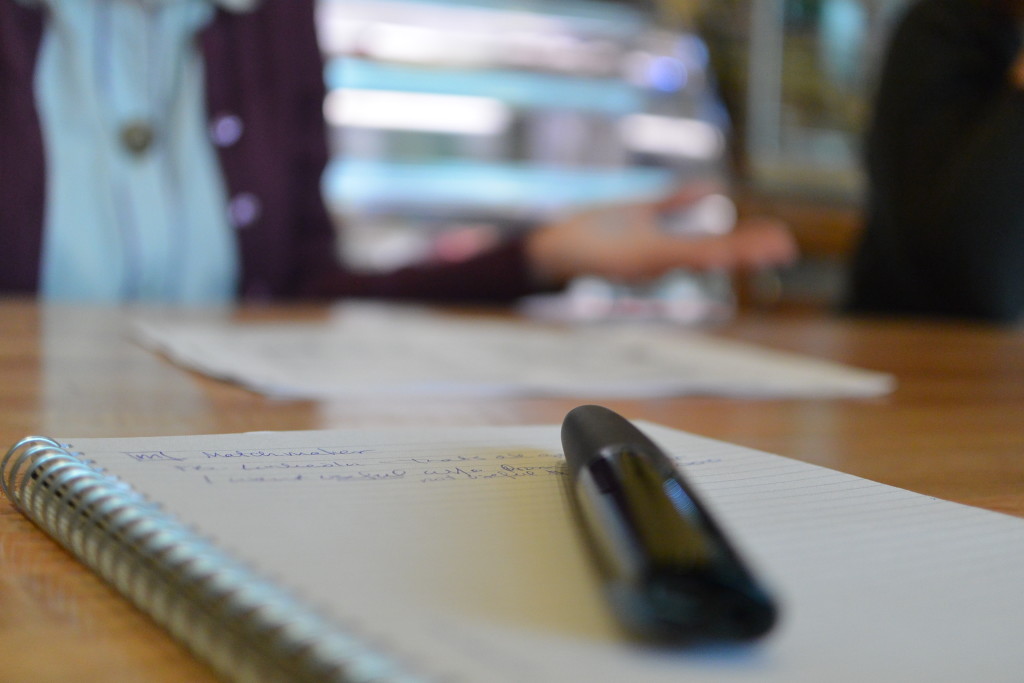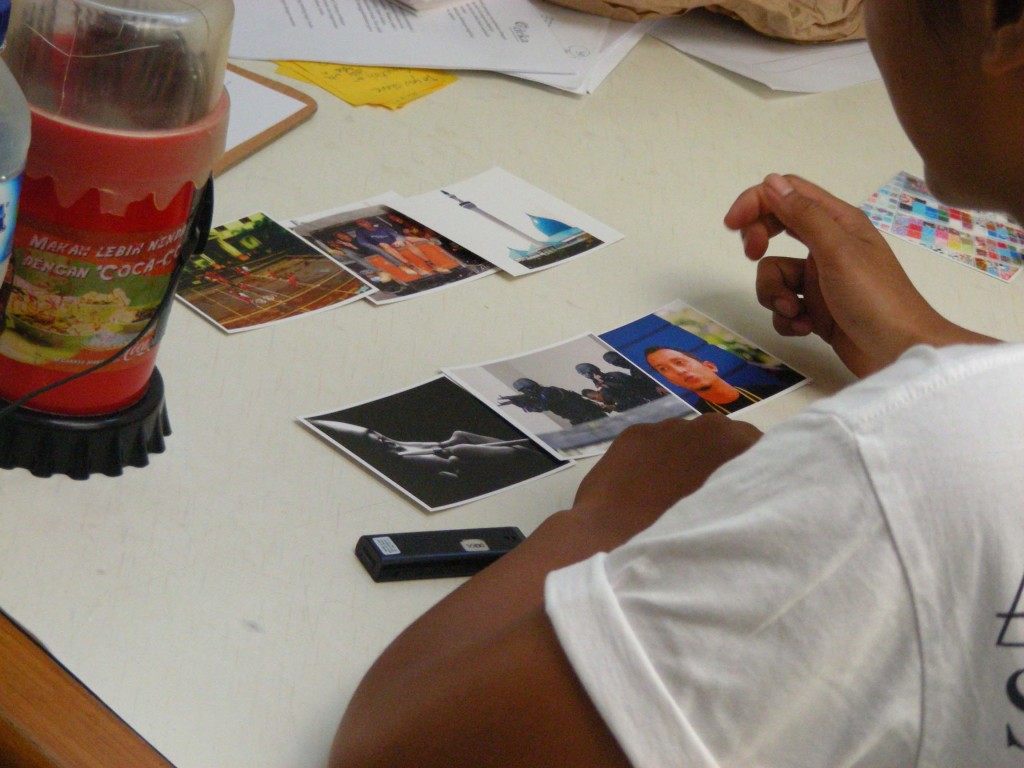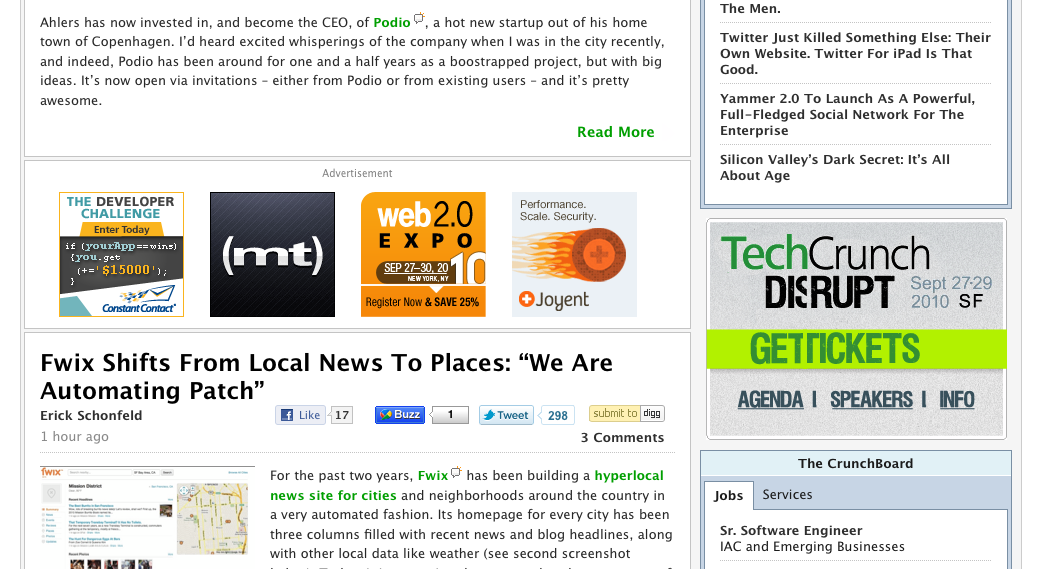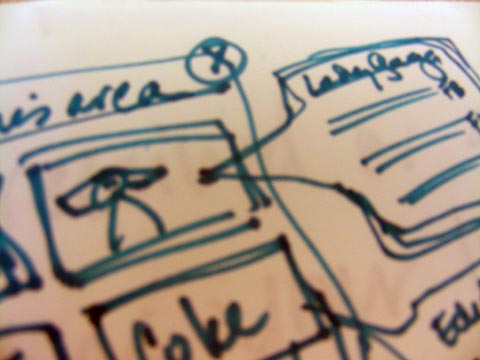Category: Innovation
The election last November shook me, as it did so many people. I became fascinated with understanding these “other” voters so that I could see, through their eyes, these issues that seemed so black and white to me. I started to see the complexities in the challenges of American identity, job creation, political accountability. I began to search for books that might explain some of it, and there were a few that helped to describe the problem, but of course, most academics don’t propose solutions. That’s what designers do. But these topics are so much more complicated than the bounded problems we typically work on when there is a client, a set amount of time, a set amount of money and an expected outcome.
What would it mean to work on a design challenge that could take 100 years to solve? 50 years, ok, 20 years, if that helps it feel more plausible.
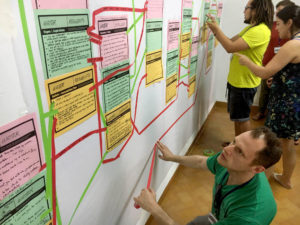
It turns out that Terry Irwin, the head of the School of Design at Carnegie Mellon is exploring this right now. She has instigated a new practice in Design called Transition Design, which comes out of her Ph.D. research with ecologist Gideon Kossoff, and philosopher turned design professor, Cameron Tonkinwise. The three of them propose that in response to the failure of Ecology and Sustainability to sufficient change behavior and improve attitudes toward more long-term thinking about the earth, Design may be able to help. But only with new tools to handle the complexity, new mindsets to deal with such long-term challenges and new training in systems of change.
I have to admit that I never personally connected with the Green Design movement, so I was surprised to find myself excited about Transition Design. But I think it is because Transition Design can be used to tackle any number of societal issues we face today, and it approaches with a great deal of empathy and a curiosity about the causes and mindsets that are at the root of the problem.
I was invited to attend a 5-day course in Spain with Terry, Gideon, and Cameron. The course had an incredible diversity of attendees: some service designers, some design professors but also community organizers and NGO workers– from all over the world. The attitude these three leaders take is that this discipline of design is just beginning, the same “problem worrying” they apply to Transition challenges, they apply to the development of the tools and methods themselves. It is all work in progress, and they invite us all to try it out and build on what is there.
We believe that rich stories and visual frameworks help to establish a new understanding of what is meaningful to people. This foundation helps researchers, designers, engineers and business leaders develop strategies and concepts together, based on a new, shared perspective.
1. Seek to be surprised
Relax into the trusted approach. Absorb everything because you don’t know where the solution will be. Resist narrowing too quickly.
2. Collaborate to learn and teach
Bring stakeholders into the field—and through synthesis-— to build a shared understanding of the opportunity well before the final deliverable.
3. Form a point of view
Innovation research is more of an art than a science. Curate a compelling call to action rather than reporting on everything observed.
4. Visualize relationships
Frameworks are powerful tools that can highlight important aspects of your story. They can be used again and again by stakeholders.
5. Focus on the elements of a good idea
Most organizations don’t suffer from a lack of ideas, they struggle with a lack of focus or a strong reason to pursue the right ideas.
Our goal is to establish a shared understanding of the opportunity area, then we can identify the elements of successful concepts. We generate the solutions together, with our client’s in-house expertise.
We have 3 favorite tools that help us collect great stories and build more beautiful presentations in the end:
– LiveScribe Pen: This pen captures audio and uses special paper to link the audio to whatever is written at that moment in time. We use this to be sure that we capture exact quotes. It’s especially useful to use when shadowing someone during an ethnographic observation– where you might be wandering through the mall or sitting quietly in their home all day. You can leave the pen running all day, capturing any small bits of conversation without turning a recorder on and off.
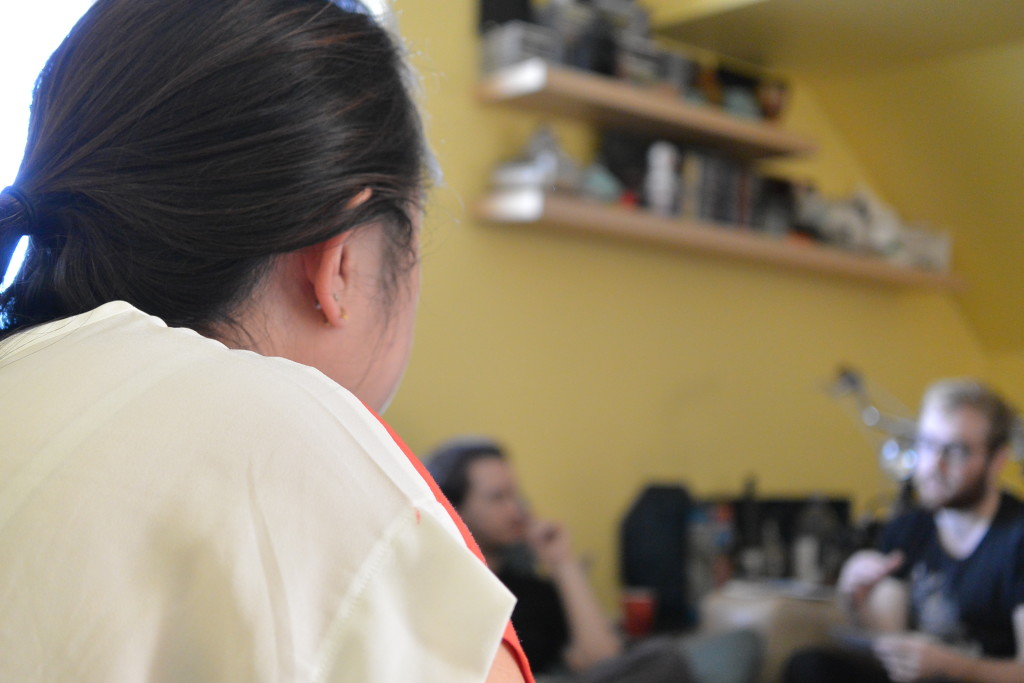
Our favorite camera allows us to take more dynamic photos, with strong focus contrast between foreground and background
– Lumix Gx7 Camera. This camera takes great photos in low-light (essential for in-home interviews) and has a touch-screen interface that allows you to touch the screen to indicate where to focus the lens. This helps us capture dynamic photos that focus on the objects or people that are most interesting.
– Photo Card Sort. Years ago I created an InDesign document with photographs sourced from as many different terms I could think of to type into Flickr and pull from my own persona photos. I focused on amorphous, non-concrete words like “communication” “spirit” “inspiration” to lead me to photos that could be interpreted not for the object they represented but what they could symbolize to people. We’ve used it again and again to prompt conversation. It works for several reasons:
- It gives people something to look at besides the person interviewing them.
- Beautiful photos encourage them to be creative.
- Asking them to describe opposites shows the facets of an experience. For example it was very revealing when we asked, “Choose three cards that describe how you like to communicate and three that describe how you don’t like to communicate.”
- The limited set of responses forces them to think about different aspects of their experience, they have to reflect on their feelings and the photos. Sometimes it’s a stretch, and they admit that, but it’s still interesting. We are looking for inspiration here, and this helps.
Contact us if you would like a PDF copy of these cards.
What tools do you love when you are seeking inspiration from field research?
Helen Walters writes, once again, about how Design Thinking isn’t the magic bullet that some of us like to think it is, in a FastCo post. I found this paragraph helpful in articulating the value proposition of Participatory Innovation:
For designers to have strategic impact, they need to work with managers to ensure that the business elements of a project are being catered to, too. That might not play to the innate strengths of designers, but it’s vital for leaders to figure out ways for everyone to get along so that innovation can be a team sport. Otherwise, we’ll be left with bizarre stories such as the one that ran recently in The New York Times, with a Smart Design director arguing that the Flip camera was, in fact, just about perfect. Just not so perfect that Cisco didn’t decide to discontinue making the product. Executives don’t always make the right decisions, of course, and perhaps Cisco management did make the wrong call in this instance. But proclaiming that smartphones had no bearing on that discussion and arguing that all of the design decisions were correct smacks of hubris and myopia. Design doesn’t — shouldn’t — live in a bubble and designers need to bridge the divide between their world and business, not just lob ideas over the fence and hope for the best. As it stands, it takes a particular type of person who can span those two worlds. Those are the must-hire employees of the future.
from Phsyics Web
“The Wisdom of Crowds” seems to be a sound idea, one many people get behind. But beyond the obvious application to user generated content, James Surowiecki runs into trouble trying to help businesses understand how to apply this principle in practice.
But I am enjoying hypothesizing that Roberto Verganti would agree that both he and Mr. Crowd are suggesting that good ideas (smart, accurate ideas in Surowiecki’s case, Design-Driven Innovation in Verganti’s case) comes from choosing the a diverse crowd and collaborating on ideas with them.
“The Wisdom of Crowds” describes the necessity of “cognitive diversity” to aggregate ideas, in fact, it is detrimental to continue to collaborate with a group of people who all think the same way about a problem. When you embrace the conflict that arises when a group of people with different perspectives hammer on a problem, better decisions result.
In “Crowds” the synthesis of ideas happens out in the open– the crowd does the work of finding the patterns and “truth” within the topic. In Verganti’s inspiration networks the synthesis may happen within the designer’s head as she or he aggregates multiple points of inspiration from diverse collaborators. But both emphasize the importance of reaching out beyond our own environments to find inspiration in new perspectives.
In the Carnegie Mellon Design program we were taught that Designers are experts in process, rather than topics. The pride of a CMU designer is that we can design “anything.” That works pretty well if you work in a consultancy, where everyone is expected to switch topics every few months, and enjoy it.
But when you work in-house, the expectations for your domain knowledge are much higher. I work for an internet company, and it is natural for people to expect me to know a great deal about technology. But I don’t. I know a great deal about people and how they behave and how they express themselves. And I know how to learn more about that. And I know how to get people to share their thoughts with me in a way that answers questions that are very difficult to answer.
But it erodes my credibility when I don’t know the latest TechCrunch opinion. So, of course, I try to read more blogs and articles. I try to use the latest apps and services. I have a twitter account: hillarydesres.
But in reality, I’m never going to spend all of my free time keeping up on the latest technology. But I’ve realized that through consistent collaboration with teammates, I learn far more than I would on my own. When I need to know the latest technology– or the latest anthropological theories– I know who to ask. I think of it as outsourcing my knowledge. I have all the knowledge I need– I just keep it stored in other people’s brains.
It can be difficult to incorporate new methods into your projects, particularly for two reasons: your confidence and your stakeholders’ confidence. But the solutions are the same: arm yourself with as much knowledge as possible before beginning to plan.
1. Imagine what you’ll learn. Don’t be afraid to share it with others. It can seem wrong to guess at what user’s will say, especially if you believe that surprise is the mother of innovation. But stakeholders need to understand why you are doing what you are doing. It’s unlikely they’ll support you if you can’t paint a picture of the results for them.
“I’ve chosen to conduct research in Indonesia because studies show that they are very mobile-phone centric. So I think we may learn a lot about how other countries could begin using mobile phones in the future.”
“I’m planning to interview ‘extreme’ examples of our users. For example, an interview with a CEO may teach us a lot about how all business people use their communication tools. Maybe they have ways of organizing information that everyone could use…”
After you’ve conducted the research you’ll have real stories that trump the guesses, so the guesses won’t matter. They are just tools to get buy-in and help gather support for trying new methods. But they will have helped YOU think through what you are hoping to gain from the method.
After working for several years at a design and innovation firm, I’d grown to rely on Designers for creative problem solving… sort of thinking of myself as the person who leads the framing of the interesting, relevant questions and Designers as the ones who lead the elegant solution-finding. But in my new position I’ve been without Designers on my team. But because I position myself as a Design Researcher, I wanted to deliver insights that had solutions, at least the beginning of solutions, attached to them.
That’s when I realized that this was a chance to rely on the kindness of teammates. And they’d probably enjoy it along the way. I turned each of my findings presentations into brainstorming sessions– presenting compelling user stories alongside opportunity areas. I asked questions like “Imagine that 10 years from now we are wildly successful as _______. What would that experience be like?” And asked engineers, product and marketing managers to grab a sharpie and some half-sheets of paper and tell me what I didn’t already know.
It has been a great way to understand what my brilliant teammates know about the opportunity areas– and they have diverse perspectives. It’s also been a great way to learn what is most surprising and inspiring to the teams. Some insights they nod their heads, sometimes they even say, “we’re already working on that.” But other insights spark great conversations, light bulbs pop up around the room. Those are the topics I dig deeper into.
The best part is that I did this before delivering my final report. So now, as I craft that massive presentation, I know what my stakeholders care about. I know more about it than I did before. And I have funny little sketches to illustrate many of the important points.
Insights must incite. If a fantastic insight falls in the forest and no one hears it, is it still valuable?
What Design brings to research to make it more suitable for innovation is not better research methods.
The creative-thinking and rule-breaking of design does little to improve the reliability of research… what it does bring is a new perspective on the problem:
- Seek more interesting users (extreme people with strong ideas and opinions)
- Ask more surprising questions (to learn the unexpected)
- Look between the lines (discover the latent needs that describe opportunity areas)
- Focus on the future (forget describing what is currently happen, predict what logically comes next)
- Focus on what is actionable (forget describing the entire experience, illuminate what has potential)
- Deliver findings in a compelling way (use visuals to make insights more accessible)
- Design the experience of receiving the insights (no more PowerPoint– get your listeners involved)
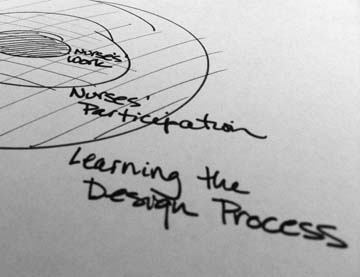
There is a complexity to systemic design challenges that is becoming clearer to me as we move through the hands-on phase of prototyping in context with nurses. The experience I am leading in this project has many experiences nested inside it. And it is useful to imagine how this project might be different if we realized the nestedness of these experiences in planning the phases.
Most of our energy, and the weight of the work, has been on “transforming” the 4 new hires within the client’s innovation group. This is a huge learning experience for them, and we wanted them to feel inspired and in-control of what they were learning, constructing the experience themselves. Which has, actually, made their experience rather self-centered–which is a wonderful way to be for people who are learning.
But the experience that is nested within their experience, is that of participatory design. The fundamental belief of the innovation group is that the ideas are developed by, with and for the end-user, in our case: the nurses. Which is a very un-self-centered approach. Egoless, even. And I think that we didn’t move into that mode of thinking soon enough. Now it is difficult for the team to give up their own needs for the needs of the nurses, and they continue to have the attitude of learners, without having the service mentality that comes with consulting and developing alongside the hospitals.
And to go one last step further, the ultimate experience that is nested within that participatory design process is that of the nurse in his or her daily work. The nurses are participating in designing something that will soon become a process that they need to follow as a requirement of their job. Thank goodness they have a chance to influence it and have their voices heard. But it needs to be more than a fun and engaging process. It requires them to think critically about what they can change and what they can sustain in their work.
So it seems that each of these experiences needs it’s own ground-rules and structure. And in thinking about a next project, it would interesting to try to identify all of them up front, and perhaps begin with the central experience as the starting point. Rather than working from the outside-in, as we have for this project.


